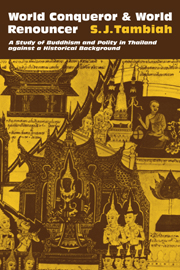 World Conqueror and World Renouncer
World Conqueror and World Renouncer Book contents
- Frontmatter
- Contents
- Acknowledgments
- PART ONE
- PART TWO
- 13 The Composition and Distribution of Religious Personnel: What the Figures Say
- 14 Monkhood as an Avenue of Social Mobility
- 15 Monastic Careers and Monastic Network
- 16 Patronage of the Sangha and the Legitimation of the Polity
- 17 Reformism and Ideological Transformation Based on Tradition
- 18 Missionary Monks (Thammathud) and National Development
- 19 The Politics of National Development and the Symbols of Legitimacy
- 20 Dialectical Tensions, Continuities, Transformations, and the Uses of the Past
- Bibliography
- Index
16 - Patronage of the Sangha and the Legitimation of the Polity
Published online by Cambridge University Press: 10 November 2010
- Frontmatter
- Contents
- Acknowledgments
- PART ONE
- PART TWO
- 13 The Composition and Distribution of Religious Personnel: What the Figures Say
- 14 Monkhood as an Avenue of Social Mobility
- 15 Monastic Careers and Monastic Network
- 16 Patronage of the Sangha and the Legitimation of the Polity
- 17 Reformism and Ideological Transformation Based on Tradition
- 18 Missionary Monks (Thammathud) and National Development
- 19 The Politics of National Development and the Symbols of Legitimacy
- 20 Dialectical Tensions, Continuities, Transformations, and the Uses of the Past
- Bibliography
- Index
Summary
The Formal Hierarchy of Offices
Mulder (1969) has provided a useful chart indicating the hierarchical structure of the sangha and how it relates to the governmental system (and at the base to the village population). We may conveniently use it (Figure 16.1) as our point of departure.
At first sight it becomes obvious how the sangha hierarchy is directly modeled on the civil administration (even though the upper echelons of the organizational structure were radically changed in 1963). Today the supreme patriarch parallels the prime minister, and the Council of Elders the Council of Ministers; and again the territorial administrative divisions of the sangha and the polity (according to region, province, district, and village) closely parallel each other. It is also remarkable how the number of lay and religious officials at regional, provincial, district, and commune levels are closely matched, the symmetry disappearing only at the lowest level of wat and hamlet/village (muban). On account of these formal similarities we might be seduced into thinking that there is a dual pattern of ecclesiastical and secular authority in Thailand, each being supreme in its own domain, both finally converging at the apex under the umbrella of the king, who is both head of government and protector of Buddhism. This impression is only partially true, because this formal patterning does not reveal the political reality behind it, a reality that signifies asymmetry rather than equality.
- Type
- Chapter
- Information
- World Conqueror and World RenouncerA Study of Buddhism and Polity in Thailand against a Historical Background, pp. 365 - 400Publisher: Cambridge University PressPrint publication year: 1976


